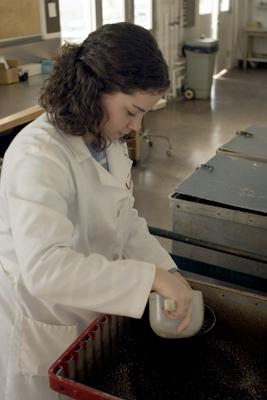In his book, Without Prejudice, Israel Zangwill asks “Do plants dream?” Do plants have yearnings, wishes or ambitions? Upon walking through the glass doors to N.C. State’s phytotron, one might assume that the answer is “yes.”
Tucked away into a corner of Gardner Hall there exists a world — a simple world that is precious, even if it is artificial in nature.
Here, plants (as well as the occasional animal, insect or pathogen) are given the perfect parameters with which to grow in and flourish.
While some shoots and roots are subjected to the ills of the outside world, certain specimens are allowed to enjoy the worry-free solace of staring off into space in a quiet, clean and controlled environment tended by a team of caring professionals.
This is the stuff that plant dreams are made of — this is the phytotron.
“The whole idea behind the phytotron is to have a very precise and reproducible environmental control,” Judith Thomas, director of the phytotron, said.
Inside the phytotron’s 54 growth chambers, scientists, researchers and students are able to create environments to their liking by controlling aspects of temperature, day length, relative humidity, nutrient concentration and pH, amongst other variables.
“We can create controlled environments that are able to maintain temperatures of five- to 40-degrees Celsius,” Janet Shurtleff, the research unit manager at the phytotron, said.
Inside the growth chambers, environmental conditions are made to mimic those found in deserts, the arctic and even space.
“Controlled growth chambers are the only way that we can grow plants in space on board the Space Shuttle and the International Space Station,” Chris Brown, director of the North Carolina Space Initiative and instructor of space biology, said.
Aside from lecturing and directing space-based programs in North Carolina, Brown is also the director of the space biology lab at the Kennedy Space Center in Florida.
“Controlled chamber research is critical for NASA as they develop long-term life support systems based on plants,” Brown said.
Gregory Goins, a research scientist at Kennedy Space Center, shared in Brown’s sentiments.
“The beauty of the phytotron is that in a controlled environment you can eliminate numerous confounding or limiting variables that exist in the field,” Goins said. “Statistically, we can rule out what is error or chance in an experiment when we have that level of control.”
He received his PhD. in crop science from N.C. State and is now studying the use of light-emitting diodes for growing crops in space.
“It doesn’t make sense to try to have a phototron out-produce what is growing out in the field,” Goins said. “Sunlight is free; where as growing plants under a phytotron is very expensive.”
According to Chris Brown, the cultivation of economical plants such as neutraceutical, transgenic, medicinal and rare species is where a lot of the phytotron’s future worth lies.
“A lot of the phytotron’s value is in being able to grow high value plants,” Brown said.
He also noted that a lot of work that came out of the University’s phytotron went on to affect research at NASA.
“Dr. [Robert J.] Downs did some of the seminal work on lighting systems that carried over into NASA’s bioregenerative life support program,” Brown said.
Not only was Downs the original director of the phytotron upon its completion in 1968, but he also helped to discover phytochrome, a pigment in plants that responds to light and regulates growth.
“Downs and Judy Thomas have produced a lot of work that we rely on,” Gary Stutte, a research scientist at the Kennedy Space Center, said. “We still communicate a great deal.”
Even though the University’s phytotron is one of the largest, most extensively used controlled environment labs in the world, its doors are left open to local students and civilians.
Every spring semester, more than 400 BIO 183 students are given the chance to conduct experiments in the phytotron among seasoned scientists, postdoctoral students and graduate students from all over the world.
“I definitely didn’t think that opportunities like this were available to freshman,” Meghan Lock, a freshman in biological sciences, said.
Many of the undergraduates who walk through the halls of the phytotron had never heard of it before.
“As big as [the phytotron] is, I’m surprised that I didn’t know that it existed,” Jenna Stover, a freshman in biological sciences, said.
David Cole, a senior in biological sciences, researched Tobacco Blue Mold for the plant pathology department in the phytotron.
“I never saw myself doing agricultural research before working at the phytotron,” Cole said, “Now I’m a federal employee with the USDA on Centennial Campus.”
For some students, the amount of freedom they’re given in the phytotron’s labs is a welcome surprise.
“You get to have a lot of control here,” Stephen Fuchs, a freshman in biological sciences, said, “It’s unlike high school where you’re always being told what to do.”
Stover said she agreed with Fuchs.
“They’re really helpful here,” Stover said, “It’s a little intimidating, but fun.”
Fun appears to be in full supply within the halls of the phytotron. Men and women wearing white lab coats go about their business with smiles on their faces, the air in the lobby is pleasantly scented with a burning candle and Valentine’s Day cards are scattered about walls and desks alike.
“Nine different departments on campus use our facilities,” Shurtleff said smiling. “People from all over the world come here. We have a lot of fun.”
Just as the plants respond well to their controlled environments, the research scientists respond well to working with the phytotron.








